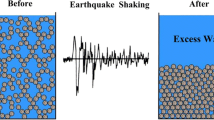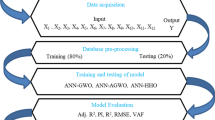Abstract
Shear wave velocity (V S) is a basic engineering soil property implemented in evaluating the soil shear modulus. In many instances it may be preferable to determine V S indirectly by common in-situ tests, for instance the standard penetration test. In this paper, the relation between V S and geotechnical soil parameters such as standard penetration test blow counts (N160), effective stress and fines content, as well as overburden stress ratio \({(\sigma_{\rm vo}/ \sigma_{\rm vo}^\prime)}\) is investigated. A new polynomial model is proposed to correlate geotechnical parameters and V S, predicated on a total of 620 data sets, including field investigation records for the Kocaeli (Turkey, 1999) and Chi-Chi (Taiwan, 1999) earthquakes. This study addresses the question of whether group method of data handling (GMDH) type neural networks (NN) optimized using genetic algorithms could be used to (1) estimate V S based on specified geotechnical variables, (2) assess the influence of each variable on V S. Results suggest that GMDH-type NN, in comparison to previous statistical relations, provides an effective means of efficiently recognizing the patterns in data and accurately predicting the shear wave velocity. The sensitivity analysis reveals that \({{\sigma_{\rm vo}/ \sigma_{\rm vo}^\prime}}\) and fines content have significant influence on predicting V S.

Similar content being viewed by others
References
Kramer, S.L.: Geotechnical Earthquake Engineering. Prentice Hall publishing, Upper Saddle Hill River, 653 p. (1996)
Andrus R.D., Piratheepanthan P., Ellis B.S., Zhang J., Juang C.H.: Comparing liquefaction evaluation methods sing penetration—VS relationships. Soil Dyn. Earthq. Eng. 24, 713–721 (2004)
Ardalan H., Eslami A., Nariman-Zadeh N.: Piles shaft capacity from CPT and CPTu data by polynomial neural networks and genetic algorithms. Comput. Geotech. 36, 616–625 (2009)
Kalantary F., Ardalan H., Nariman-Zadeh N.: An investigation on the Su–NSPT correlation using GMDH type neural networks and genetic algorithms. Eng. Geol. 104, 144–155 (2009)
Imai, T.; Yoshimura, Y.: The relation of mechanical properties of soils to P and S-wave velocities for ground in Japan Technical Note OYO Corporation, In: 4th Japan Earthquake Engineering Symposium, pp. 89–96 (in Japanese) (1975)
Sykora, D.E.; Stokoe, K.H.: Correlations of in-situ measurements in sands of shear wave velocity. Soil Dyn. Earthq. Eng. 20, 125–36 (1983)
Jafari M.K., Shafiee A., Ramzkhah A.: Dynamic properties of the fine grained soils in south of Tehran. J. Seismol. Earthq. Eng. 4(1), 25–35 (2002)
Hasancebi, N.; Ulusay, R.: Empirical correlations between shear wave velocity and penetration resistance for ground shaking assessments. Bull. Eng. Geol. Environ. 66, 203–13 (2007)
Ulugergerli, U.E.; Uyanık, O.: Statistical correlations between seismic wave velocities and SPT blow counts and the relative density of soils. J. Test. Eval. 35, 1–5 (2007)
Dikmen, U.: Statistical correlations of shear wave velocity and penetration resistance for soils. J. Geophys. Eng. 6, 61–72 (2009)
Pitilakis K., Raptakis D., Lontzetidis K.T., Vassilikou T., Jongmans D.: Geotechnical and geophysical description of Euro- Seistests, using field and laboratory tests, and moderate strong ground motions. J. Earthq. Eng. 3, 381–409 (1999)
Kiku, H.; Yoshida, N.; Yasuda, S.; Irisawa, T.; Nakazawa, H.; Shimizu, Y.; Ansal, A.; Erkan, A.: In-situ penetration tests and soi profiling in Adapazar Turkey Proc. In: ICSMGE/TC4 Satellite Conference on Lessons Learned from Recent Strong Earthquakes, pp. 259–265 (2001)
Tamura, I.; Yamazaki, F.: Estimation of S-wave velocity based on geological survey data for K-NET and Yokohama. J. Struct. Mech. Earthq. Eng. I, 237–248 (in Japanese) (2002)
Ohta Y., Goto N.: Empirical shear wave velocity equations in terms of characteristic soil indexes. Earthq. Eng. Struct. Dyn. 6, 167–187 (1978)
Mayne P.W., Martin G.K.: Commentary on Marchetti flat dilatometer correlations in soils. ASTM Geotech. Test. J. 21(3), 222–239 (1998)
Mayne, P.W.: Stress-strain-strength-flow parameters from enhanced in-situ tests, Proceedings. In: International Conference on In-Situ Measurement of Soil Properties and Case Histories (In-Situ 2001), Bali, Indonesia, pp. 47–69 (2001)
Hanna A., Ural D., Saygili G.: Neural network model for liquefaction potential in soil deposits using Turkey and Taiwan earthquake data. Soil Dyn. Earthq. Eng. 27, 521–540 (2007)
Cetin, K.O.; Youd, T.L.; Seed, R.B.; Bray, J.D.; Stewart, J.P.; Durgunoglu, H.T.; Lettis, W.; Yilmaz, M.T.: Liquefaction-induced lateral spreading at izmit bay during the Kocaeli (Izmit)-Turkey Earthquake. J. Geotech. Geoenviron. Eng. 130, 12, December 1, 2004. © ASCE, ISSN 1090-0241
Risk Management Solutions Inc. Event report: Chi-Chi, Taiwan earthquake. CA, USA (2000)
Chua D.B., Stewarta J.P., Leeb S., Lind P.S., Chud B.L., Seed R.B., Hsuf S.C., Yug M.S., Wang C.H.: Documentation of soil conditions at liquefaction and non-liquefaction sites from 1999 Chi-Chi (Taiwan) earthquake. Soil Dyn. Earthq. Eng. 24, 647–657 (2004)
Scawthorn, C.: Earthquakes of 1999. In: Euro conference on global change and catastrophe risk management: earthquake risks in Europe, Laxenburg, Austria (2000)
Ivakhnenko, A.G.: Polynomial theory of complex systems. IEEE Trans. Syst. Man. Cybern.; SMC-1:364–378 (1971)
Farlow, S.J.: Self-Organizing Method in Modelling: GMDH Type Algorithm. Marcel Dekker Inc., New York (1984)
Nariman-Zadeh N., Darvizeh A., Jamali A., Moeini A.: Evolutionary design of generalized polynomial neural networks for modelling and prediction of explosive forming process. J. Mater. Process. Technol. 164-165, 1561–1571 (2005)
Nariman-Zadeh N., Darvizeh A., Ahmad-Zadeh G.R.: Hybrid genetic design of GMDH type neural networks using singular value decomposition for modelling and prediction of the explosive cutting process. J. Eng. Manuf. 217, 779–790 (2003)
Dimopoulos I., Chronopoulos J., Chronopoulos-Sereli A., Lek S.: Neural network models to study relationships between lead concentration in grasses and permanent urban descriptors in Athens city (Greece). Ecol. Model. 120, 157–165 (1999)
Castillo D.E., Gutierrez J. M., Hadi A.L.: Sensitivity analysis in discrete Bayesian networks. IEEE Trans. Syst. Man. Cybern. 26, 412–423 (1996)
Author information
Authors and Affiliations
Corresponding author
Rights and permissions
About this article
Cite this article
Mola-Abasi, H., Eslami, A. & Shourijeh, P.T. Shear Wave Velocity by Polynomial Neural Networks and Genetic Algorithms Based on Geotechnical Soil Properties. Arab J Sci Eng 38, 829–838 (2013). https://doi.org/10.1007/s13369-012-0525-6
Received:
Accepted:
Published:
Issue Date:
DOI: https://doi.org/10.1007/s13369-012-0525-6




